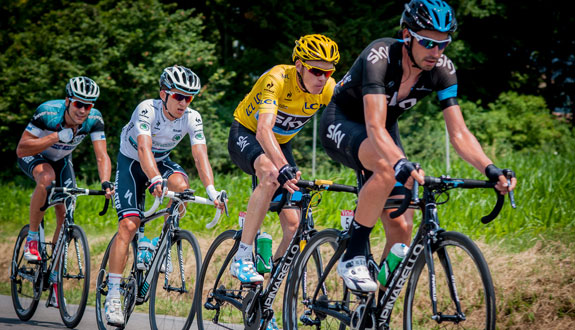These Tour de France Part to Whole LSAT Flaws are Dope
- by
- Jul 23, 2013
- LSAT, Sports
- Reviewed by: Matt Riley


If you have the will — and the stamina — to spend about four hours a day watching men exercise in tight-fitting clothes, then you probably already know that Chris Froome has won the Tour de France. The Tour is a showcase for mental toughness, advanced materials, aerodynamic research, and, unfortunately, pharmaceutical science. Blood doping and EPOs probably won’t help you do better on the LSAT, but using cycling to understanding the tricky Part to Whole flaw will.
Tour de France Part to Whole LSAT Flaw #1: The Fastest Riders Make The Fastest Team
Let’s say that Team Merck has the best coach, the fastest climber, the fastest time trialist, the fastest sprinter, and the fastest domestique (the guy who brings everyone their water bottles and snacks). Clearly, Team Merck is the fastest team. Right? Well, what if none of the team members listen to the coach, the climber tries to sabotage the time trialist, the sprinter only cares about himself, and the domestique spits in everyone’s water? So, even though Team Merck has all the fastest parts, the parts could just work together poorly. Maybe Team Pfizer is the faster team, because, even though they don’t have all the fastest parts, their parts work better together.
Tour de France Part to Whole LSAT Flaw #2: Every Cyclist is Corrupt, So Cycling is Corrupt
There’s a long list of cyclists who’ve been busted for doping. In many years of the Tour de France, a majority of the top ten finishers were involved in some kind of doping scandal. For argument’s sake, let’s say that every cyclist is corrupt. Clearly then, the sport of cycling is corrupt. Sounds like a tempting conclusion, right? Let’s rephrase this argument a bit, while keeping the logical structure the same. How about, every cyclist shaves their legs, so cycling shaves its legs. Does this sound good to you? Nah, cycling isn’t the type of thing that can have legs (metaphorical legs don’t count).
So, the whole doesn’t necessarily share a property of its parts. The key to spotting Part to Whole flaws on the LSAT is to pay close attention to the slight shift in scope that happens between the premises and the conclusion. So, look for a jump from “team members” to “teams”, from “cyclists” to “cycling”, from “trees” to “forests”. If you’d like to have some fun practicing the Part to Whole flaw, try to sucker one of your enemies in to making one of the above arguments, and then slam them with a reductio ad absurdum* counter. Everyone seems to have an opinion on doping in cycling, so this shouldn’t be too hard to pull off.
* It’s a common form of argument, not a Harry Potter spell.
Search the Blog

Free LSAT Practice Account
Sign up for a free Blueprint LSAT account and get access to a free trial of the Self-Paced Course and a free practice LSAT with a detailed score report, mind-blowing analytics, and explanatory videos.
Learn More
Popular Posts
-
logic games Game Over: LSAC Says Farewell to Logic Games
-
General LSAT Advice How to Get a 180 on the LSAT
-
Entertainment Revisiting Elle's LSAT Journey from Legally Blonde








